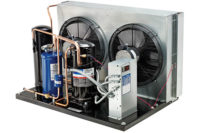With all the talk in recent years, and even more so in recent months, regarding refrigerants like CO2 and hydrocarbons (HCs) making inroads in refrigeration equipment, the trends in the ‘R’ of HVACR are even more widespread. Here is an update on some of the more recent developments.
R-718
While the number may not be all that familiar, the refrigerant certainly is. R-718 is the designation for water, just as R-290 is for the HC refrigerant propane, and R-134a is for a very familiar hydrofluorocarbon (HFC) refrigerant.
Water is one of the so-called natural refrigerants, though its applications in commercial HVACR is not as far along as other “naturals” like CO2, HCs, and ammonia. Water-as-a-refrigerant has been documented for use in an absorption chiller, which is being integrated into a district cooling system in Copenhagen, Denmark. In a report from the city’s government titled “Copenhagen: Solutions for Sustainable Cities,” the technology was described as using seawater abstraction for cooling along with a running surplus of heat from the district heating network through the absorption cooling and compression chillers.
The website www.r718.com reported that during the summer months, when heat demand is low, there is excess surplus heat in the district’s heating system. This heat is used to drive a steam double-effect absorption chiller to provide chilled water for the city’s cooling needs.
Underground insulated pipelines distribute the chilled water to help cool the indoor air within commercial and industrial buildings.
When seawater temperature is below 42˚F and the city’s cooling demand is below 2,400 kW, the cooling elements are covered by free-cooling heat exchangers. When the temperature is between 42˚ and 53˚, the heat exchangers are used for pre-cooling of the water before it is cooled by chillers. Finally, absorption and compression chillers provide cooling when seawater temperature is above 59˚. In chiller cooling mode, the free-cooling heat exchangers are bypassed.
Magnetic Refrigeration
Developments continue in terms of magnetic refrigeration, which uses a magnetic material instead of a refrigerant, and magnetizing and demagnetizing cycles instead of compression-expansion.
Manufacturers Cooltech Applications and Whirlpool are announcing plans to bring such refrigeration equipment to the market within the next two years. France-based Cooltech intends to unveil a 500 W cold counter later this year that will use magnetic principles. Cooltech’s research and development director Tim Lorkin said during an Institute of Refrigeration (IOR) meeting that the approach uses temperature change from adding and subtracting a magnetic field to provide cooling without the need for refrigerants or compressors. “Magnetic refrigeration can cover 80 percent of the vapor compressor market today — it is not a niche,” he said during the meeting.
Whirlpool’s development in-
volves the use of an iron-based alloy to provide the magnetic charge, which is said to be less expensive than using rare-earth magnets. The project centers on domestic refrigerators and was accomplished in conjunction with Camfridge, a company that specializes in magnetic refrigeration. Developers said such equipment could be on the market by 2015.
R-32
Using HFC-32 as a stand-alone refrigerant has been a popular topic amongst refrigeration gurus worldwide. R-32 has most commonly been used in a blend to create such familiar refrigerants as R-410A and the refrigerants in the R-407 series, among others. While the refrigerant was praised for its low global warming potential (GWP) and thermodynamic properties, questions arose regarding which oils work best with the refrigerant. Its A2L safety rating, when used as a stand-alone, has also drawn criticism.
Daikin recently announced that the refrigerant could be used in its air conditioners in the U.K. within two years. And the company said there are plans to introduce R-32 in air-to-air heat pump systems as soon as the fall of 2013.
The move is predicated on the expected broader acceptance of A2L (slightly flammable) refrigerants. The classification was created by ASHRAE, and now international and European standards and building regulations are undergoing modifications to allow broader use of A2L refrigerants such as R-32. But that would be contingent upon adequate training for installers and technicians as well as others in the supply chain.
The system was said to be similar to an R-410A system, but it was noted that caution was needed to avoid the possible mixture of air and refrigerant.
Publication date: 11/4/2013
Want more HVAC industry news and information? Join The NEWS on Facebook, Twitter, and LinkedIn today!









Report Abusive Comment